| Author |
Topic |
|
|
maryjane
    
7076 Posts
|
 Posted - Feb 08 2019 : 1:23:45 PM Posted - Feb 08 2019 : 1:23:45 PM


|
Because I get questions about my milking routine via email and requests from people wanting to come here for some hands-on training as an extension of my book, I thought a series of videos and photos would be of help.
My set-up is nice. I'm super appreciative, especially since it was only 13 years ago I was milking my cow Chocolate in the back of my wood shed. Even after I built my present-day parlor, it took until summer before last before I had my dream hot water tank (60 gallons!). I truly love going to my parlor every day. It's my daily Zen.
Step-by-step, here's how my routine unfolds:
Every morning, I head to my parlor carrying a crate with my EZ milking gear (clean bottles and inflations) and a bucket of clean towels. I rinse my EZ bottles in the parlor every day after I'm done but I wash/sanitize them in my kitchen using a specialty brush I buy online (the one I have presently is still in great shape; purchased 6 months ago):
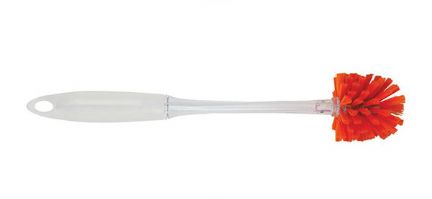
https://smile.amazon.com/gp/product/B01DZTR5SM/ref=oh_aui_search_asin_title?ie=UTF8&psc=1
I wash the inflations in my dishwasher. EZ bottles can't go into a dishwasher because the heat warps them (they're plastic). Since moisture is your enemy when it comes to sanitation, I place my EZ bottles on their sides on a heating pad covered with a towel--they dry quickly that way (4 bottles fit on one pad). Otherwise they don't dry out fast enough or at all in between milkings.
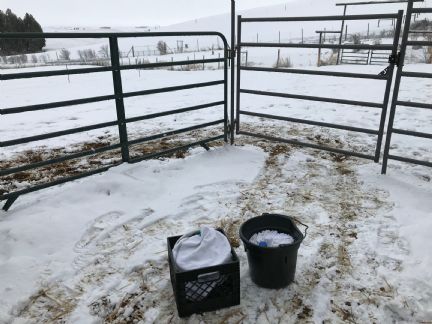
Milk maidens in waiting.
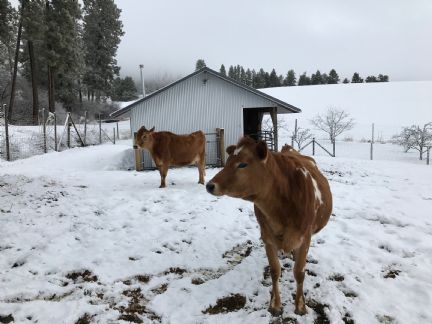
A clean parlor greets me every morning. I get it ready for the next day by cleaning everything I've used in addition to mopping the floor every day after I've finished milking.
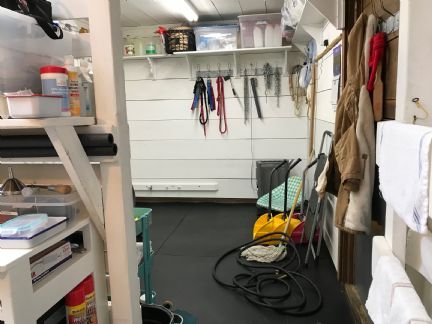
For sanitation, I have three pairs of gloves (Safeway find--about $2.50/pair--cheap). They last longer than anything else I've tried like Playtex, plus they have the perfect grip, not too thick (I like being able to feel through a pair of gloves). And they remove easily. I just pull on the fingers of each hand while fully gloved and once removed, I put the gloves in their place without touching the fingers. Instead of washing my hands frequently, I wash my gloves frequently, keeping them as clean as possible. For the pair I use for milking, I often spritz them with a spray of 200 ppm (parts/million) bleach-water solution to keep them sanitized.
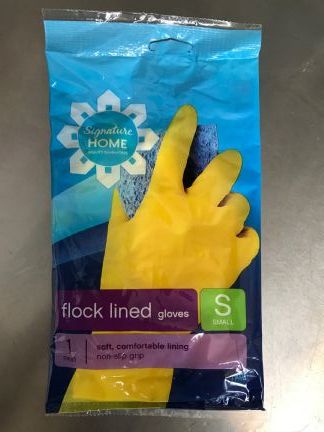
One pair is for cleaning my cows outside.
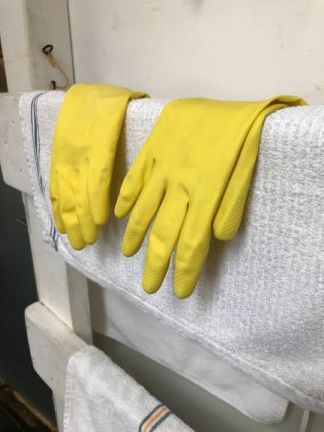
The second pair is for sink duty.
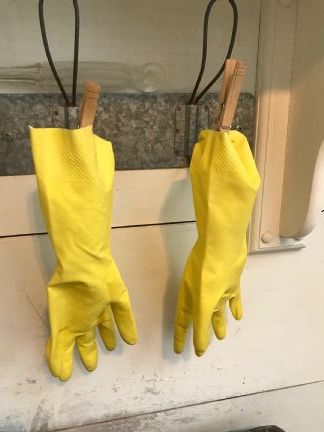
And the third pair is for use during milking.
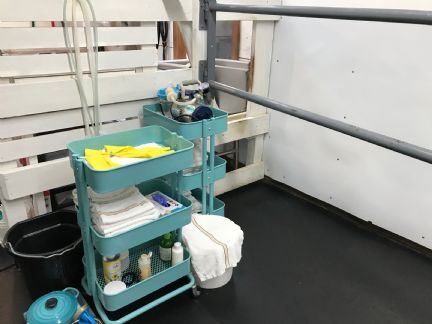
I also keep a box of nitrile disposable gloves handy for applying udder cream after I'm done milking. I put a glove on my right hand only and then toss it after I've slathered something all over an udder. Some of the creams I use have lanolin and it doesn't wash off my reusable gloves very well, hence the disposable gloves.
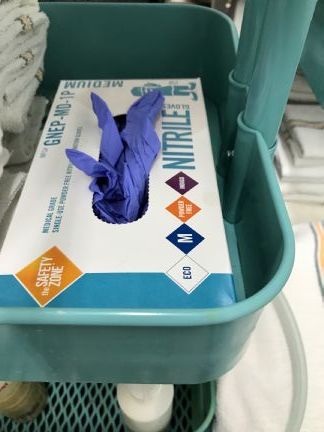
The reason I use gloves for handling my cows is not only to keep my hands from getting sore from so much soap and water, but also to protect my cows from what might be on my hands, as well as to protect me from what might be on them. Also, I'm keen on not spreading anything from one cow to the other, hence, clean hands (or in my case, clean gloves). In addition, if I'm milking more than one cow, each cow has its own set of clean bottles and inflations (2/cow) that I bring with me to the parlor every day.
I fill the inside feed tray (cleaned out the day before) with a scoop of organic alfalfa pellets and about half a scoop of organic dairy pellets (grain). Higher protein foods help them give more milk and are especially helpful in the cream realm. The extra alfalfa provides needed calcium.
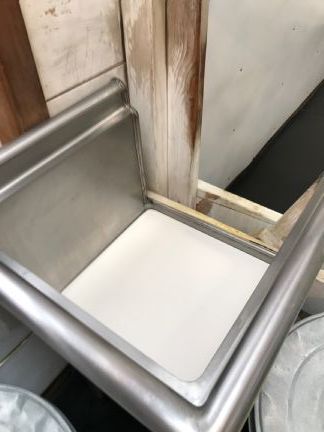
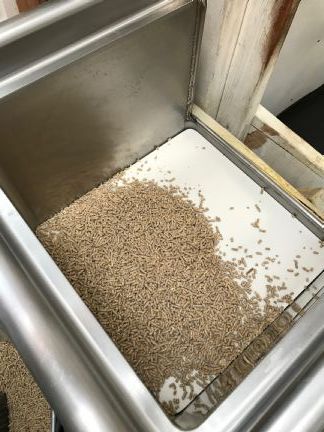
I unpack everything I brought with me and get it ready to go.
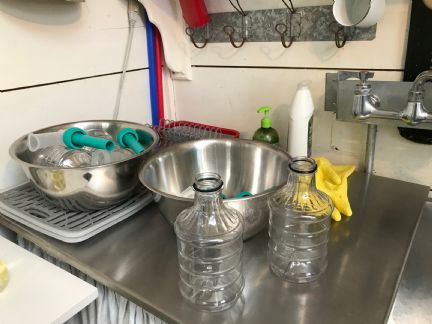
Here's everything ready to go.
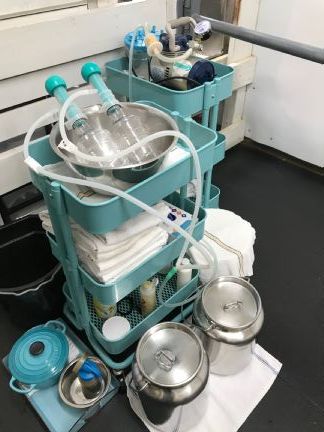
Now I'm ready to go back outside to call my cows in and clean them (they come by name--I love that part).
I'll be milking Maggie first, so I bring her to the head lock area where I have my hose.
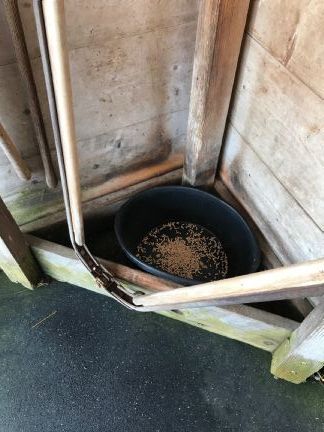
Miss Daisy is anxious to come in next.
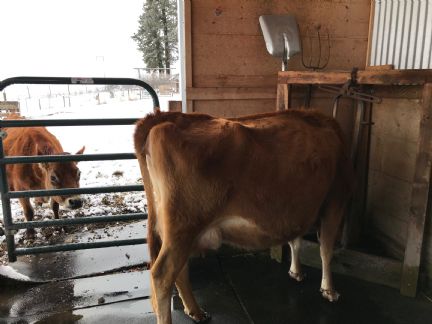
I have a back bay that she marches right into for her little bit of alfalfa pellets.
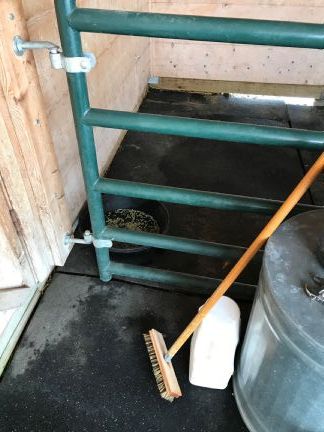
I shut the gate behind her and lock her in.
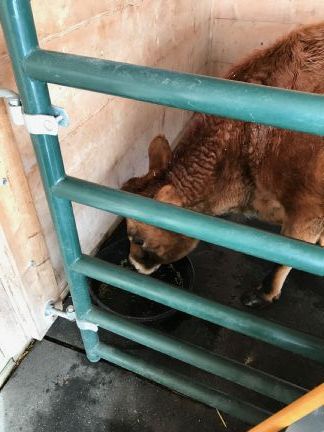
Once I bring Maggie into my parlor, I put a 1/2 cup pellets in the head lock where Maggie was so it's ready for Miss Daisy to be washed next.
My outside area has a hose for cleaning.
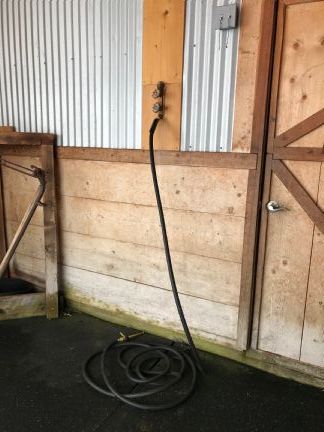
And a nifty stop-n-waste hot/cold valve that drains itself every day once I've taken the hose off (and drained it to prevent it from freezing).
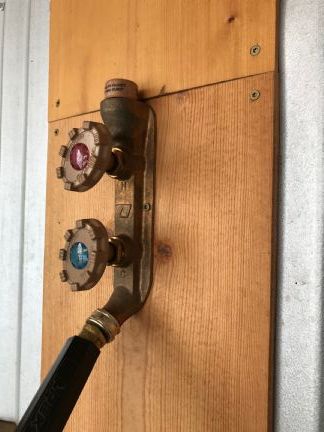
I have an upside down galvanized tank for a table.
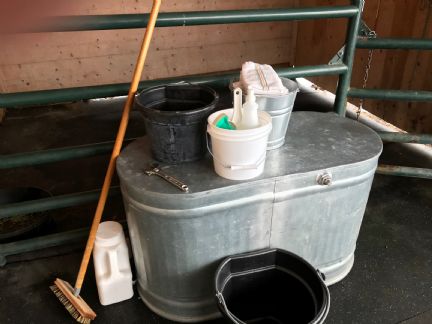
It holds my grooming supplies, my Weaver antiseptic soap, clean towels, and my CMT kit (more about that later). I have an empty bucket ready to receive soiled towels (washed and sanitized every day).
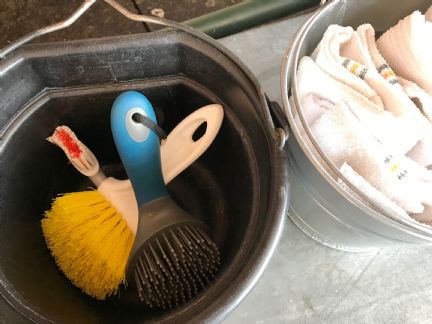
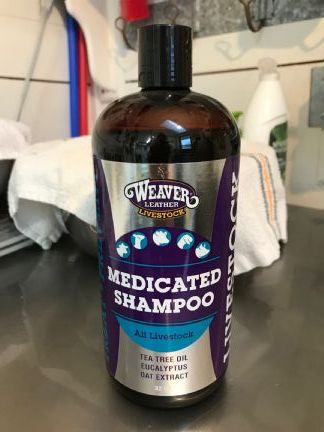
Now, I'm ready to clean Maggie.
MAGGIE 01
MAGGIE 02
I clean her teats and udder using Weaver. I keep the area just above my cows' teats shaved using an Oster "Golden A5" electric trimmer (details in my book, page 211). I have a little portable, battery-powered Wahl trimmer that I keep handy for touch-ups in the parlor. If you've ever been prepped for surgery, you know that the area that needed to be sterile was shaved first, for good reason. It's very difficult to keep hair from harboring germs no matter how much iodine you put on it.
MAGGIE 03
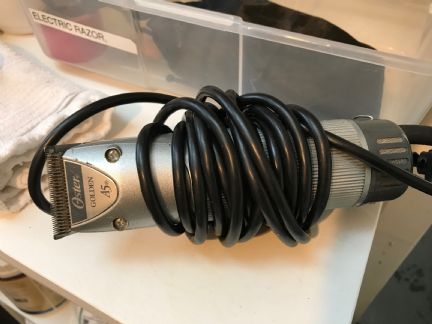
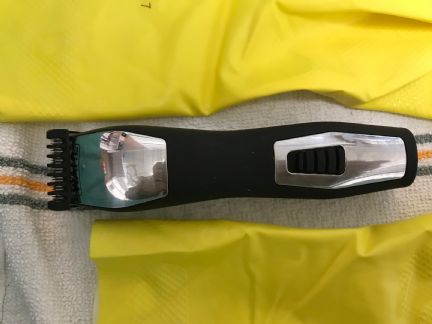
Now, I strip her teats (8 to 10 squirts/teat to get rid of milk that might not be sterile by bringing new milk into her teat orifices) as well as checking the milk for signs of mastitis using a California Mastitis Test.
MAGGIE 04
I bring the milk I've taken into my sink, add the gelling agent to each cup and check for any gelling (an indication that she's producing white blood cells because she's starting to battle an infection). All clear and good to go!
MAGGIE 05
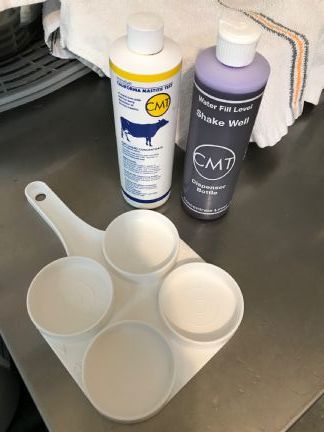
Using a clean towel, I dry her teats off so that when I coat them in iodine, the iodine won't be diluted by water still present on the teats.
MAGGIE 06
And then I wrap her tail up to keep it out of my way while I'm milking. Tails are dirty and I've never met a tail yet that stayed still for longer than two seconds. I secure the towels by using a little Velcro strap (available in most five and dime stores). That's Miss Daisy moaning in the background telling me she'd like more pellets. She's the only cow I've ever had who "talks" to me. She has quite the vocabulary. Right now, she's whining, so I'm ignoring her.
MAGGIE 07
I use an iodine cup to disinfect each teat. I make sure I bounce the cup up several times so that iodine also coats the base of the udder above each teat. I do that because sometimes the EZ inflations suck the entire teat in causing the inflation to touch the udder. And per the instructions on the label, I rinse used iodine out in between cows and have two dispensers ready to go, one for pre- and one for post-milking.
MAGGIE 08
Maggie marches right in! I put my pooper scooper and rolling mechanics chair into position and then lock her head in.
MAGGIE 09
I turn on the EZ machine and switch gloves. Using four teat wipes total, I clean the iodine off each teat, then I get to work milking.
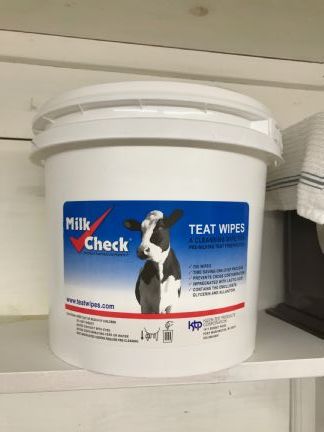
Maggie's milk comes fast and furious so I put the first bottle on and then wait a minute before putting the second one on so I'm not having to take them both off at the same time. I get my 2.5 gallon stainless steel buckets that I use to transport milk (just the right weight when full for carrying) from Hamby Dairy Supply. And yes, that's a cricket chirping you hear in the background. I have one that lives in my parlor.
MAGGIE 10
In this video, she's already given me her milk, but I go back to get more cream. It isn't much she's let down since I've quit milking her, but what little she gives me at the end is straight cream. I don't want to walk away from Jersey cream, even if it's only a half a cup. She gave me one gallon of milk total. This is the last day I'll be milking her because she's due to calve in two months. A cow needs a two-month break from giving milk so that her energies go into bringing forth a robust, healthy calf.
MAGGIE 11
I coat her udder and teats with Dynamint. Then I squeeze a little bit of milk out of each teat in case I got some Dynamint in one of her orifices. Then I dip just the very tip of each teat with iodine. A cow forms a little keratin plug during the day, so it's best if there's a little bit of iodine waiting there for extra protection. A little bit of iodine does in fact get sucked up into the orifice because I've checked by giving the teat another little squeeze and sure enough, out came some milky iodine.
MAGGIE 12
I remove the tail towel.
MAGGIE 13
And out she goes. But wait, she honored my request for a little show and tail by showing you how my pooper scooper works. Whenever my girls are in the parlor, I watch for a tail that starts to lift. When it does, out comes my yellow dust bucket.
MAGGIE 14
Now it's time to get started on Miss Daisy. I shot videos up until the time I put EZ bottles on her so you could see how different it is to milk a miniature Jersey. Miss Daisy has the body of a dachshund. In other words, her legs are short and somewhat problematic for ease of milking, but it can be done!
DAISY 01
DAISY 02
DAISY 03
DAISY 05
DAISY 06
DAISY 07
DAISY 08
DAISY 09
DAISY 10
DAISY 11
Here are a few more resources.
For udder cream, I use four different kinds, depending on what I think an udder is needing: Steuarts "Teat Heal", Dynamint, Freezegard (for when winter temperatures drop down into the single digits), and my homemade version for when they get a spot that needs extra care.
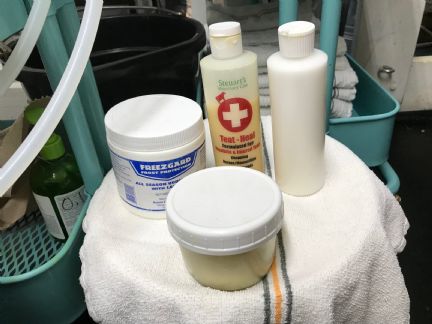
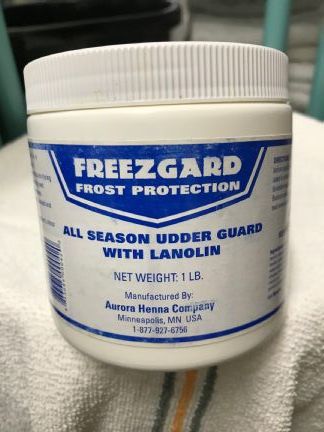
I buy Dynamint (approved for organic use) in parlor packs and then squeeze it into a smaller squeeze bottle.
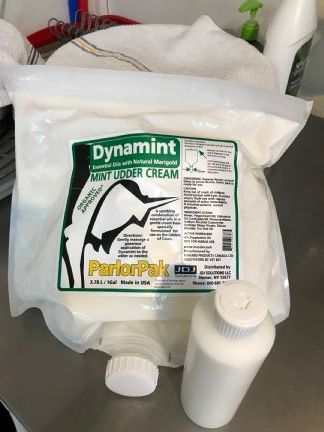
My homemade version is only pliable during the summer, so in the winter I keep a small enameled cast-iron Le Creuset pot handy (cast iron holds heat very well) and fill it with hot water before placing my udder care down in the water. I put the lid on and it's nice and soft by the time I need it.
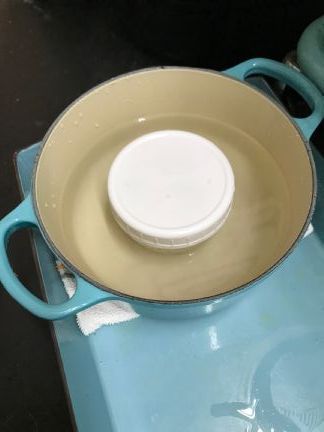
Here's the recipe:
https://heritagejersey.org/chatroom/topic.asp?TOPIC_ID=32244
For clean-up of gear that has come into contact with milk, I really like using a soap called Liquipfan (Hamby's Dairy Supply). It cuts milk fats in nothing flat without creating too many soap bubbles (everything rinses quickly).
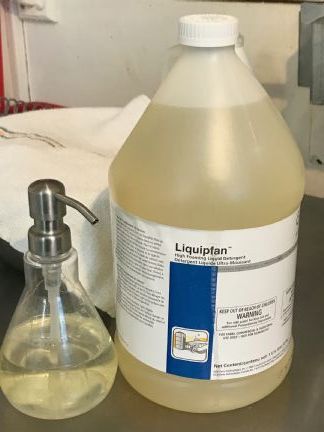
I get my post- and pre-iodine teat dip from Hamby's also.
The EZ hoses never dry out so unless I spritz them every day with a blast of 200 ppm bleach, they start to show signs of mold (they provide air suction only and are never in contact with the milk). To spritz them before hanging them to drain, I hold both ends up and fill the hoses with a bit of bleach solution using a spray bottle (a 200 ppm bleach/water solution in my spray bottle is roughly 1 teaspoon bleach/fill). Then, I drain the hoses both directions, making sure the inside has been fully coated with the bleach solution. Works like a charm. No mold ever. (Make sure you have good aim so you don't accidentally squirt some in your face.)
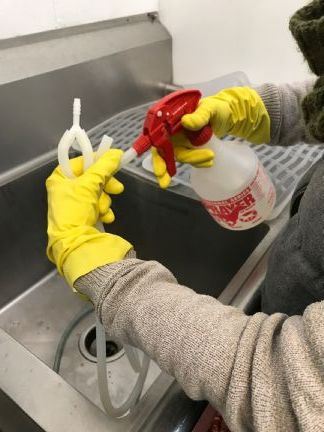
Here's a tour of my parlor.
Area above my sink.
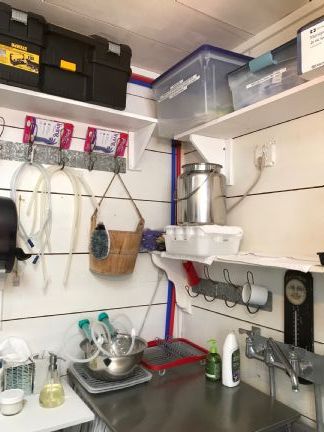
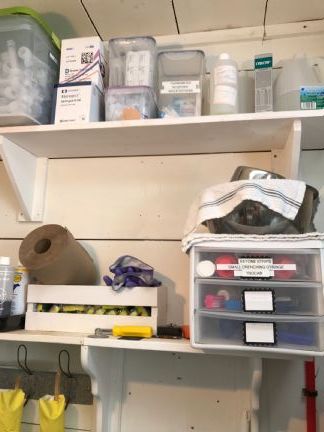
Shelves near the ceiling.
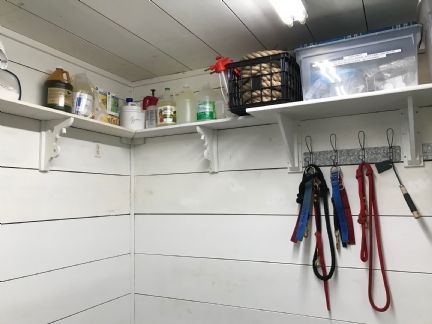
My hoof trimming gear and homemade rolling cart for catching odds and ends.
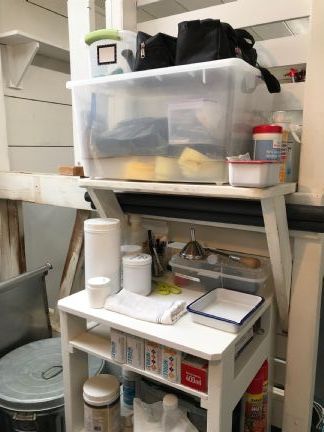
Two heaters that keep me toasty warm in the winter (they're on full-time so the pipes don't freeze).
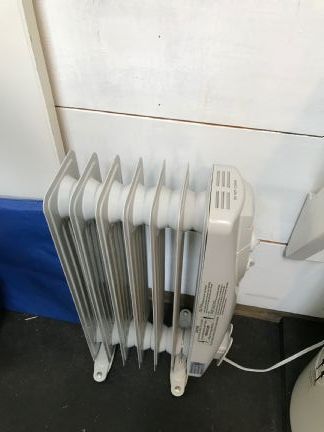
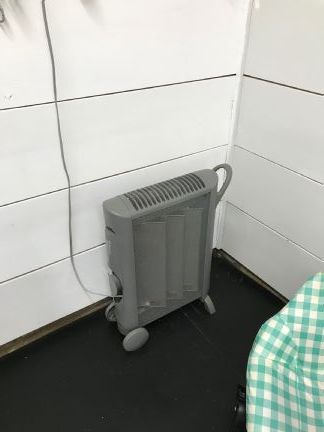
And my main crush, a 60-gallon, propane-fueled hot water tank.
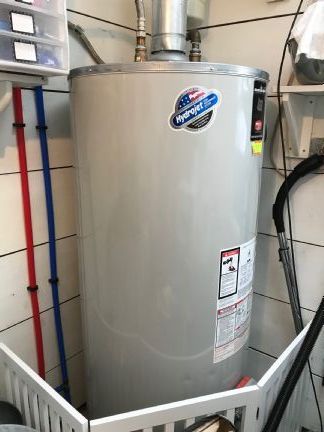
I hope this helps. Milking a cow is a work in progress. If you have any questions at all, please don't hesitate. That's what I'm here for! |
MaryJane Butters, author of Milk Cow Kitchen ~ striving for the stoicism of a cow standing in the rain ~ |
|
| |
Topic |
|
|
|
![[flourish]](/images/flourish-txt_mobius.png)
![[flourish]](/images/flourish-txt_mobius.png)